|
||||||||||
|
|
||||||||||
|
||||||||||
|
|
||||||||||

Let's start with the basics. Missile designers have two basic "problems" when it comes to creating a missile. The first is how to look for and track an aircraft (called "tracking") while the second is how to damage the aircraft once the missile gets close enough to it. In this explanation, we will only consider the tracking issue. There are several different methods of tracking a target, but we will discuss the two most common, infrared (IR) and radar (RF). Infrared guided missiles track heat sources emitted by the target.

Radar guided missiles emit radiation and track the reflected energy. In this way, these missiles are essentially miniature RADAR systems.

Since aircraft designers usually want their aircraft to both takeoff AND land, they must adopt methods of protecting their planes against missiles. These techniques are called countermeasures (abbreviated CM) and consist of devices or methods intended specifically to spoof or fool incoming missiles. The missile designers, on the other hand, won't get paid if their missiles don't work, so they must develop counter-countermeasures (abbreviated CCM) that help their missiles ignore the countermeasures.
This is the vicious cycle. For every new whiz-bang CM that is developed, someone else designs a new CCM to counter it. To keep things from getting really confusing, designers usually don't refer to CCCM's or anything with more than two C's. In general, CM usually refers to something an aircraft uses, while CCM refers to something a missile uses.
Now, for those who think my explanations are lacking, keep in mind that it is possible to write entire books on the tracking systems of missiles, and there are introductory courses that last several days. The tracking systems themselves are quite complex, and often kept under wraps. This brief answer is only intended to be the "short version" of how missiles and countermeasures work.
IR Guided Missiles
Now lets take a look at IR guided missiles. These missiles track the heat sources of an aircraft, which usually means the hot engines. There are several countermeasures that can be used against IR guided missiles, the three most common being infrared signature suppression, infrared flares (decoys), and infrared jamming.
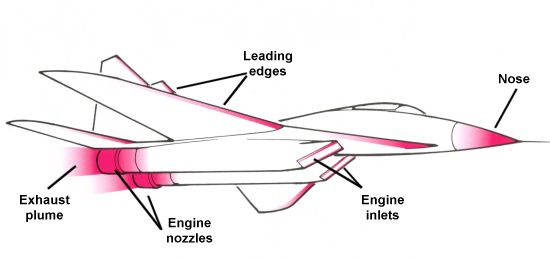
Infrared signature suppression is simply what it sounds like. If the infrared signature of an aircraft is low enough, a missile can have trouble finding the aircraft and tracking it. Here is an entertaining way to think of an IR missile versus an aircraft. Picture yourself as the IR missile...be the missile. Humans can't see in infrared naturally, so we will use the visible spectrum in our example. Picture the aircraft you are after as a flashlight, which is a pretty good approximation of what a missile seeker would actually see. It is dusk, not very sunny but not yet dark. Just as in the visible spectrum, there is ambient infrared light in the atmosphere too. Let's pretend you are hunting a MiG, which has big, hot jet engines. These engines would be comparable to the headlights of a car and are pretty easy to see against the background. In comparison, let's pretend you are now hunting a helicopter, one with a new infrared suppressor. Instead of a bright light, it looks more like a cheap flashlight with rundown batteries. It's a bit harder to see, isn't it? When you consider that a missile doesn't have quite the brain power you do, it gets even harder to see.
Now let's look at infrared flares. IR flares are nothing more than fancy road flares designed to emit IR radiation that mimics that of an aircraft. They are used as decoys. When an aircraft is being threatened by an IR missile, it ejects flares in the hopes that the missile will go after the flare, and not the aircraft. Be the missile again...picture a bright flashlight traveling across your field of view. Suddenly, several other light sources "break off" from the flashlight, and they look quite a bit like the flashlight you were following, and maybe even brighter. If you are a "dumb" missile, which light source do you go after?
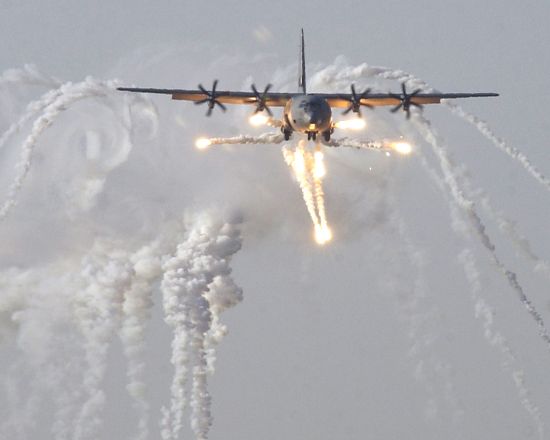
Infrared jamming is a technique that confuses a missile. Jammers are usually mounted on the aircraft they protect, and a common system is the ALQ-144 (often called the "Disco Ball"). To understand how these systems work, picture yourself in a disco hall (like you didn't see that one coming). All of the lights are out. Picture John Travolta holding a small flashlight, right in front of the disco ball. As long as the disco ball is turned off, you can pick out the flashlight just fine. As soon as someone turns on the disco ball, though, you'd be hard pressed to tell what was the flashlight, and what was the disco ball.
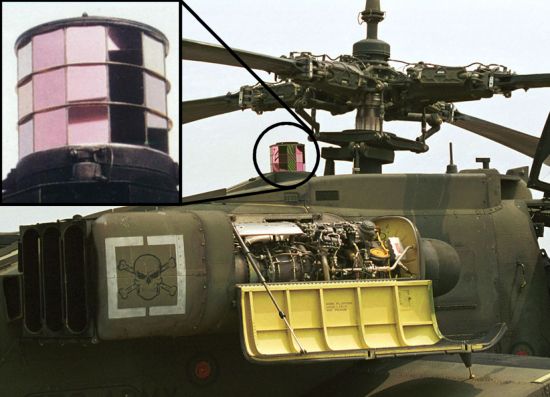
Other jamming systems have the ability to "saturate" a seeker. Imagine yourself in the same dark room, with the same small flashlight. You can pinpoint the flashlight just fine, until someone turns on a World War II searchlight in your face. Now you can't see much of anything, let alone the small flashlight.
Do these CM techniques work against incoming missiles? Of course they do! Otherwise, military forces all over the world wouldn't spend the money, or use up the space and weight on their aircraft to carry them. Which method is most effective? As usual, it depends. Jamming can be very effective, but it is usually expensive, and sometimes specific to a particular missile. Flares work rather well, but can also be missile specific. Infrared suppression is the most "universal" solution, but it is also the most difficult since reducing an aircraft's IR signature low enough to completely evade a missile is challenging. As a result, it is wise to consider a mix of all of these solutions if you are designing an aircraft that might someday be in harm's way.
RF Guided Missiles
RF guided missiles track aircraft using radar. Just like an airport control tower can track the flight inbound from Albuquerque, an RF missile can track an enemy aircraft by using radar. Curiously enough, the same three methods for countering IR missiles also apply to RF missiles, suppression, decoys, and jamming.
Since I've already beaten the flashlight analysis to death, I won't use any analogies for RF missiles. Nevertheless, the countermeasures are all essentially the same ideas as those used against IR missiles except they are applied to a different part of the electromagnetic spectrum.

Suppressing an aircraft against RF missiles is more difficult than IR suppression, but it is done regularly. Stealth aircraft are a prime example. These planes make use of methods to reduce radar cross section to make it more difficult for radars to track them.
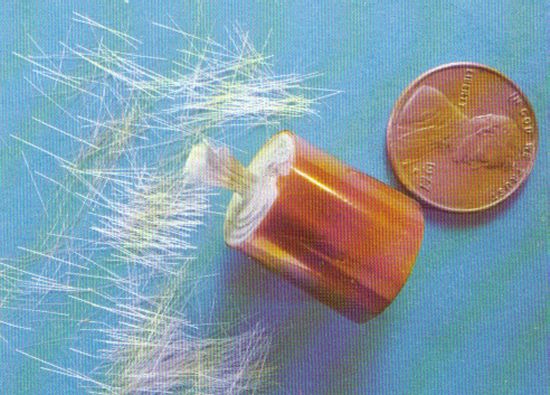
There are also decoys against RF missiles called chaff. Chaff is ejected from an aircraft, much like a flare, and it creates a cloud of material that looks like a big radar target to an RF missile. The missile either goes after the larger target, or the target can be obscured by the cloud of chaff.
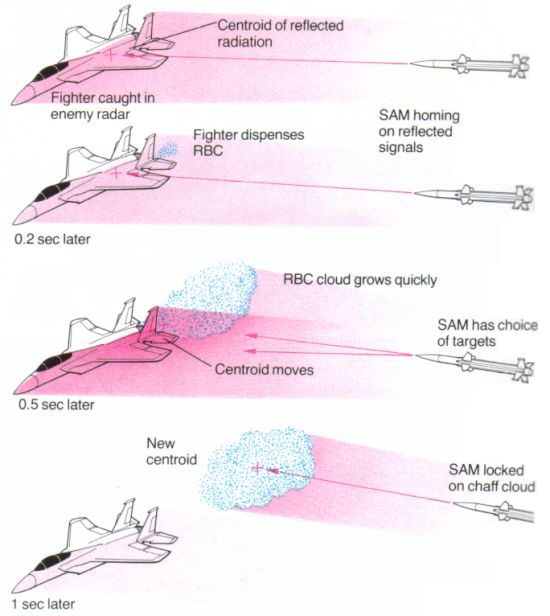
Jammers, again, work much like those in the IR world. Radar jammers often send out large amounts of RF energy that essentially saturate or confuse an RF seeker. If a jammer sends out enough energy, the missile seeker isn't able to pick out a small target among all the "noise" generated by the jammer. Dedicated jamming aircraft like the EA-6B Prowler are considered essential escorts when sending strike aircraft against heavily defended targets.
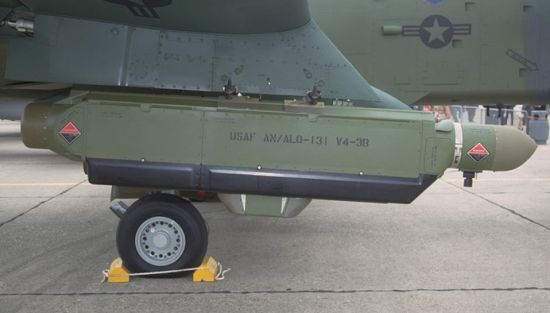
Much like the IR world, picking out the "best" method for RF missile countermeasures isn't really possible. There are many factors to be considered, and often the best approach is a balanced one using all of the different techniques to achieve the best chances of evading a missile.
Summary
That is the "crayon version" of missiles and countermeasures. While RF and IR missiles operate in different areas of the same spectrum, the techniques they use to track aircraft, and the techniques used to counter them, are very similar. All of the techniques talked about here are effective, although to varying degrees. Some techniques are better against certain missiles or engagement scenarios, but all of them "work" to some degree, otherwise they wouldn't be installed on practically every military aircraft in service today.
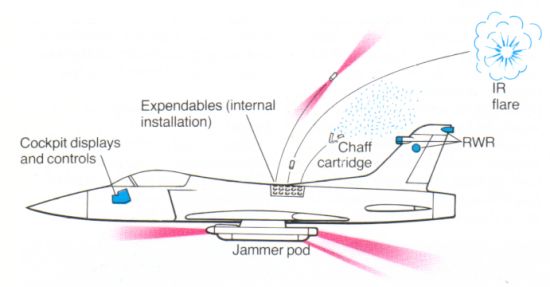
And I bet you'll never look at John Travolta the same way again!
- answer by Doug Jackson, 29 August 2004
Related Topics:
Read More Articles:


|
Aircraft | Design | Ask Us | Shop | Search |

|
|
| About Us | Contact Us | Copyright © 1997- | |||
|
|
|||